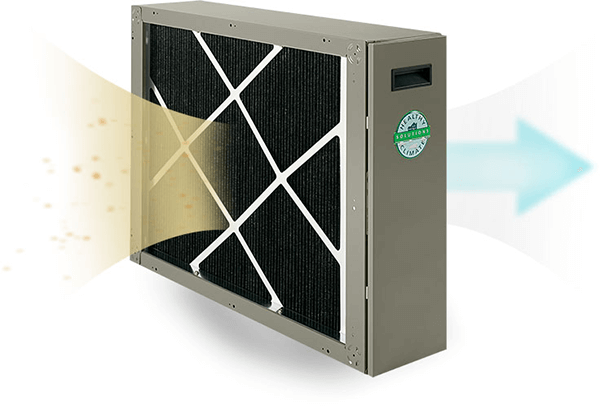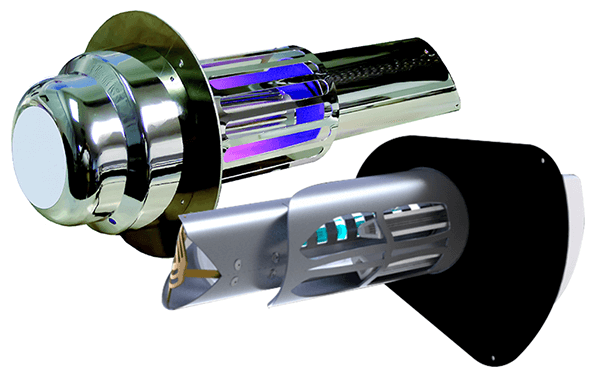Central Air Filters & Air Purifiers: A Great Team!
When ‘air pollution’ comes up in conversation, the image it conjures for most people might be smog along the horizon. Yet, many homeowners are unaware that the air inside their homes often contains a higher concentration of pollutants than outdoors.
As codes for new home construction continue to limit allowable air leakage for the sake of energy efficiency, and many older homes are upgraded to embrace the current standards, this issue continues to grow.
Given this setting, indoor air quality (IAQ) is a real and legitimate concern.
While air filtration has been on homeowners’ minds for about as long as there has been central forced air heat, in recent decades the importance of enhanced air filtration and purification has never been more relevant. Let’s learn more.
Indoor Air Pollution
According to the EPA, indoor air pollution can have both immediate and long-term effects. Immediate effects can include irritation of the eyes, nose and throat, headaches, dizziness and fatigue. Long-term effects can include respiratory diseases, heart disease and cancer.
Indoor pollutants have a significant presence in most homes, courtesy of the many byproducts of everyday life. The EPA categorizes indoor air pollutants into two broad categories, particulate matter and gaseous products.
Particulate matter includes things such as airborne dust, pet dander, pollen, molds — and even bacteria, viruses, and organic chemicals attached to microscopic airborne particles.
Gaseous indoor pollutants may also include bacteria, molds and viruses, plus tobacco smoke, heating and cooking combustion products, and volatile organic compounds (VOCs) originating from construction materials, paint, solvents, cleaners, caulking, adhesives, dyes, deodorizers, pesticides, and more.
Given these potential health risks, let’s review ways to help clean that air up. Our discussion will concentrate on whole-home products that can be installed in central ducting systems, for homes heated by a forced air furnace or which have an independent air handling system.
Central Air Filters vs. Central Air Purifiers
Centrally installed air cleaning products can be grouped into two categories: filters to capture airborne particulate matter, and purifiers for neutralizing gaseous pollutants. Following is an overview of some of the more common products in both categories.
Central Air Filters
To address airborne particulate matter, there are a variety of high efficiency filters that can be installed in a central ducting system to replace the popular, yet limited, 1″ filters found in most homes. These enhanced filters are often contained in a special housing installed next to your furnace or air handler, and typically require custom sheet metal adapters to maintain proper airflow. Here’s a survey of some of the more popular high performance furnace filters currently available:
Media air filters
 Media filters, or media air cleaners, are large, replaceable, pleated filters typically ranging from 4″ to 9″ in thickness.
Media filters, or media air cleaners, are large, replaceable, pleated filters typically ranging from 4″ to 9″ in thickness.
Media filters are far more effective than standard filters, and because of their large surface area, usually require less frequent replacement — every three to twelve months, depending on the filter and the application. Simple and efficient, and quite popular.
While highly effective, media air filters also create a greater restriction to airflow, making it important to verify that your HVAC system can handle this additional pressure drop.
One nice feature of media filters is that they have no mechanical parts so you don’t have to worry about them breaking down. The only maintenance cost is the replacement filter.
HEPA filters
High-efficiency particulate arrestance (HEPA) filters are the highest-performing air filters.
The first HEPA filter was designed in the 1940s as part of the Manhattan Project, and subsequently these filters have been used in laboratory/clean room applications for many years. They have since been adapted for residential applications.
Because HEPA filters are very restrictive to airflow, they operate by diverting a portion of the airstream from the main duct system, clean it, and then return it to the main flow. This means that a small space is needed in the mechanical area for the unit to reside.
While tops in performance, HEPA filtration is usually the highest cost option for both initial installation and subsequent maintenance.
Electronic Air Cleaners
Another well-known product that has been around for a long time, these filters use electricity to create charged dust particles which are drawn to and collected by oppositely charged metal collector plates.
Electronic air cleaners carry very strong performance ratings and create less airflow restriction than media air filters, which is a nice advantage. The frequency of cleaning needed to maintain the effectiveness of the collector plates has been the subject of much debate, and the cleaning process itself can be tedious. If poorly maintained or malfunctioning, they can produce unhealthy levels of ozone.
Central Air Purifiers
Developed to counteract gaseous indoor pollutants, central air purifiers have steadily grown in popularity. The goal of this newer class of products is to remove or neutralize airborne chemicals, germs, and odors which are not captured by high efficiency filters. Here are highlights of different approaches and products currently available:
Activated Carbon
Also known as activated charcoal, activated carbon is an additional feature available in some of the central air filters described above, such as the popular media filters. Activated carbon absorbs odors and specific gases, and requires regular replacement to remain effective.
Ultraviolet Air Treatment
Products featuring ultraviolet (UV) lamps installed in the ducting are intended to kill airborne bacteria, germs and mold spores by irradiation in the airstream and on exposed duct surfaces.
These products have a fixed location in the duct system and thus require the contaminant to be ‘in view’ to be effective. This product typically has a stronger market demand in areas of high humidity, to help control bacterial growth, but can still can provide benefit in Colorado.
Photocatalytic Oxidation (PCO) and Plasma Purifiers
 PCO air purifiers work by shining UV light on special catalyst material in the unit, creating airborne molecular ions that react with and neutralize a variety of odors, chemicals, bacteria, viruses and other potentially harmful air components. PCO products can be easily installed into most central ducting systems as a standalone product (our most popular air purifier), and are also available in combination with a media filter.
PCO air purifiers work by shining UV light on special catalyst material in the unit, creating airborne molecular ions that react with and neutralize a variety of odors, chemicals, bacteria, viruses and other potentially harmful air components. PCO products can be easily installed into most central ducting systems as a standalone product (our most popular air purifier), and are also available in combination with a media filter.
Plasma-generating air purifiers, which differ in design from PCOs, produce a similar class of ions, and exhibit like results.
Depending on the version of the product selected, these products can clean air throughout the entire home, rather than relying on air circulating passed a fixed filter location.
Source Control and Proper Ventilation
Along with products to help clean up polluted indoor air, the EPA also recommends embracing enhanced source control and proper ventilation practices. You may find that improved storage and cleaning practices and paying closer attention to the ingredients in some products you bring into your home can immediately help lessen the pollution presence.
In addition, make sure household exhaust fans (kitchen, bathrooms, workshop, etc.) are working properly, and use them as recommended by their manufacturers.
For enhanced ventilation, you may also wish to learn more about products designed to efficiently bring fresh air into your home, such as energy recovery ventilators.
Contact a Pro for Advice!
Quality central air filters and air purifiers can be installed individually, but are also a great complement to each other. In combination, they will do the best job of cleansing pollutants from your indoor air.
For expert advice on these and related products such as central humidifiers, in the Denver and Boulder, Colorado area, contact Save Home Heat Company.




